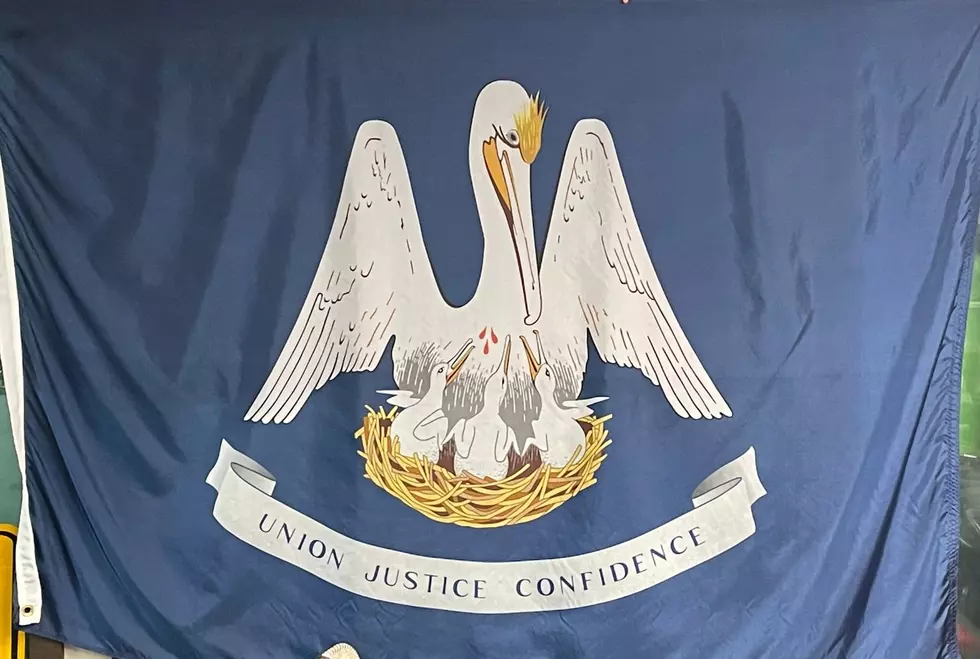
How Much Do You Know About the Louisiana State Flag?
I love the fact that right behind me in the KEEL studio hangs the State Flag of Louisiana. Regardless of her shortcomings, I'm proud to have been born in Louisiana. I wish we had more of Texas' attitude towards state pride.

Because Louisiana has been influenced by England, Spain, and of course, France, our culture is unlike that of any other state. One example is, we're the only state with parishes, as opposed to counties. And our state flag represents a lot of those different influences. Throughout the 1800's, the state flag was based on France's flag. The pelican design wasn't introduced until 1912.
Blue Background
Starting with the background, you first notice the state flag has a blue background. The color blue represents truth. But the flag's blue is not just any blue, the official color for our flag is azure. Falling between blue and cyan on the color spectrum, the azure shade offers a pleasing background for the white pelican.
The Pelican
The flag features our state bird, the brown pelican. (Although the pelican depicted on our flag is white. This is thought to be an aesthetic decision) Interestingly, the particular design of the pelican is thought to symbolize the french influenced fleur-de-lis. And if you look, you can see it. But why the pelican to begin with? I found this explanation at countryroadsmagazine.com:
After the United States bought Louisiana in 1803, the land that would comprise our state was named the Territory of Orleans. President Thomas Jefferson appointed 28-year-old William C. C. Claiborne governor, and the territory’s legislative council authorized him to design an official government seal. Claiborne adopted a seal depicting an eagle holding a laurel wreath in its beak with fifteen stars arranged at the bottom to represent the states of the Union. But after Louisiana became a state in 1812, the seal was changed to a pelican perched on its nest, plucking at its breast to draw blood to feed its ten chicks (oddly, the pelican’s head was originally shaped like an eagle, or a “condor” as one historian described it). This early seal also had the state’s motto “Justice, Union & Confidence” as well as eighteen stars representing the states.
Why Claiborne changed the seal from an eagle to a pelican is not clear, but it might have been his way to honor the state’s Catholic heritage. In ancient times, people believed the pelican would tear the flesh from its own body to feed its young in times of famine. Early Christians tapped into this common belief and began using the pelican as a symbol for Christ’s sacrifice and blood atonement. As late as 1812, a Catholic prayer book used a pelican as a symbol of self-sacrifice, and it looked identical to the one on Louisiana’s 1813 seal.
The Three Drops of Blood
The flag has gone through several iterations through the years before settling on the current version. The drops of blood show the pelican tearing at her breast to feed her babies. This was an ancient belief about the pelican, although today, experts agree a pelican would not actually self-harm to feed its' young. The previous version didn't have the blood drops, and in the early 2000's, an eighth grade student noticed this, and wrote a letter to lawmakers pointing it out, and legislation was written to change the flag design to add the drops of blood back in. And in 2010, officials introduced the current version that the three drops of blood reincorporated back into the flag design.
The State Motto
The flag also features the state motto, adopted in 1902, "Union, Justice, Confidence" printed in blue across a white banner at the bottom
What Are the Largest Cities in Louisiana?
Closest National Parks to Shreveport
More From News Radio 710 KEEL









